ALLERGY ACUPUNCTURE
An Effective Option for a Stubborn Problem
I am pleased to announce that I am now a certified provider of Soliman Auricular Allergy Treatment (SAAT). This innovative approach involves the precise placement of semi-permanent needles in the external ear for the purpose of reducing the body’s response to formerly allergenic substances.
Given the huge adverse impact of allergies on the quality of life of millions of sufferers and given that the existing options for patients with allergies have been limited to this point to symptom-masking medications with serious side effects (such as antihistamines and steroids) and/or treatments that involve significant expense (such as years or even decades of allergy shots or lengthy courses of treatment with acupuncture and herbal medicine), I am excited about this promising technique.
Check out this recent case series in which 96% of subjects with alpha-gal allergy experienced remission following SAAT.
Please note that some of the explanations below are based on my own conjecture and do not necessarily represent the viewpoint of Dr. Soliman, Dr. Liebell, and/or other SAAT practitioners.
If you believe that you may be suffering from alpha gal allergy (red meat allergy), check out this recent PBS segment about alpha gal syndrome and SAAT: Alpha-gal Syndrome: Why Can’t I Eat Meat?
What is SAAT?
SAAT stands for Soliman Auricular Allergy Treatment. It is a revolutionary technique invented by Nader Soliman, M.D., a board-certified specialist in anesthesiology, pain management, and medical acupuncture. I was privileged to learn this technique directly from Dr. Soliman and am a certified provider of SAAT.
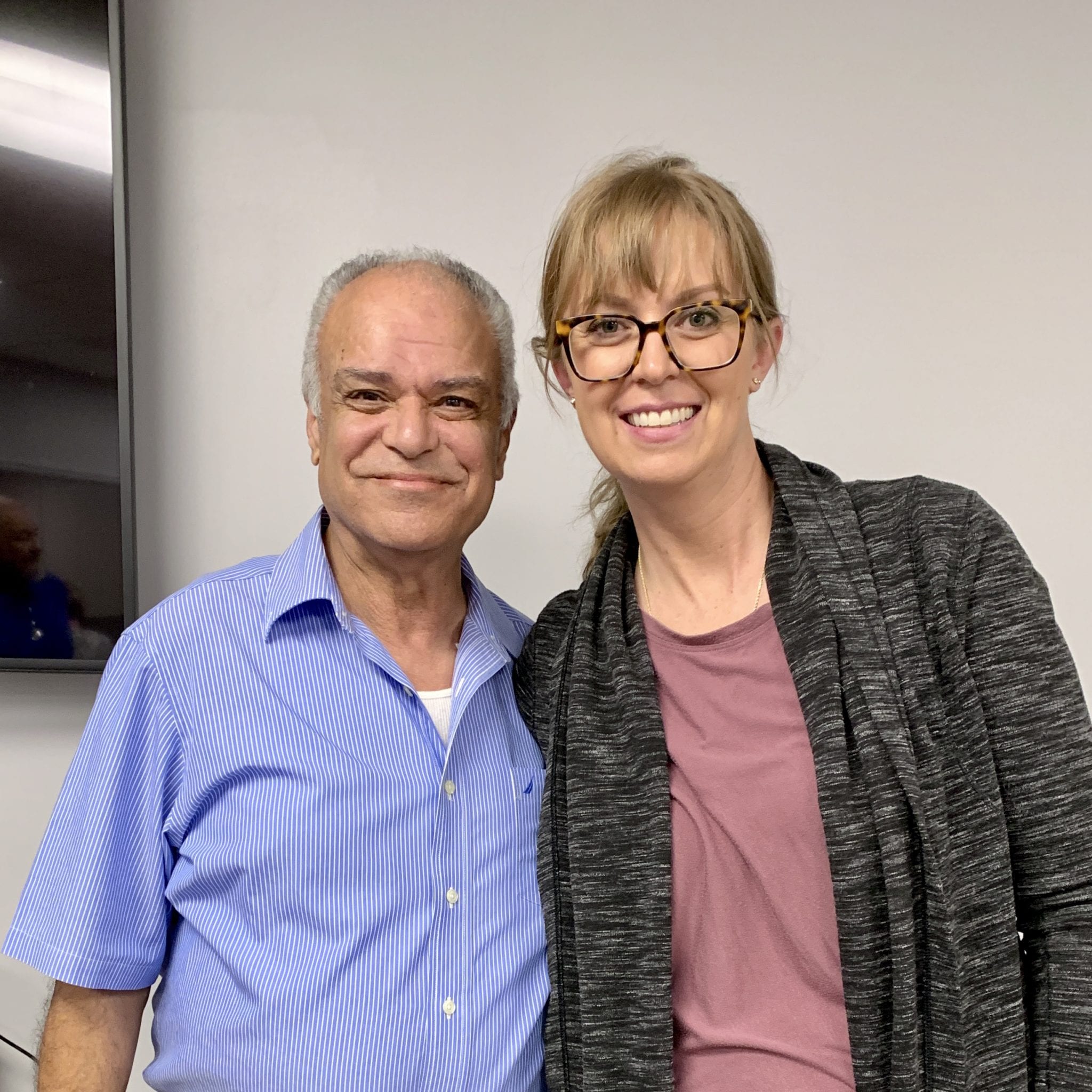
SAAT is a simple technique that uses only one needle and often requires only one treatment for any particular allergen (substance causing allergic reaction). This technique has proven to provide the strongest relief from allergy symptoms among all known acupuncture techniques.
What are the needles like? Does it hurt? How do the needles stay in place?
The needles used for SAAT are extremely small. A single needle is inserted at an extremely precise location for each allergen that is being treated (this location will vary from one patient to the next). The needle is inserted parallel to the skin surface and, once it is in place, most patients are not able to feel it at all.
The needle(s) are then firmly affixed in place for 3-4 weeks using medical adhesive and tape.
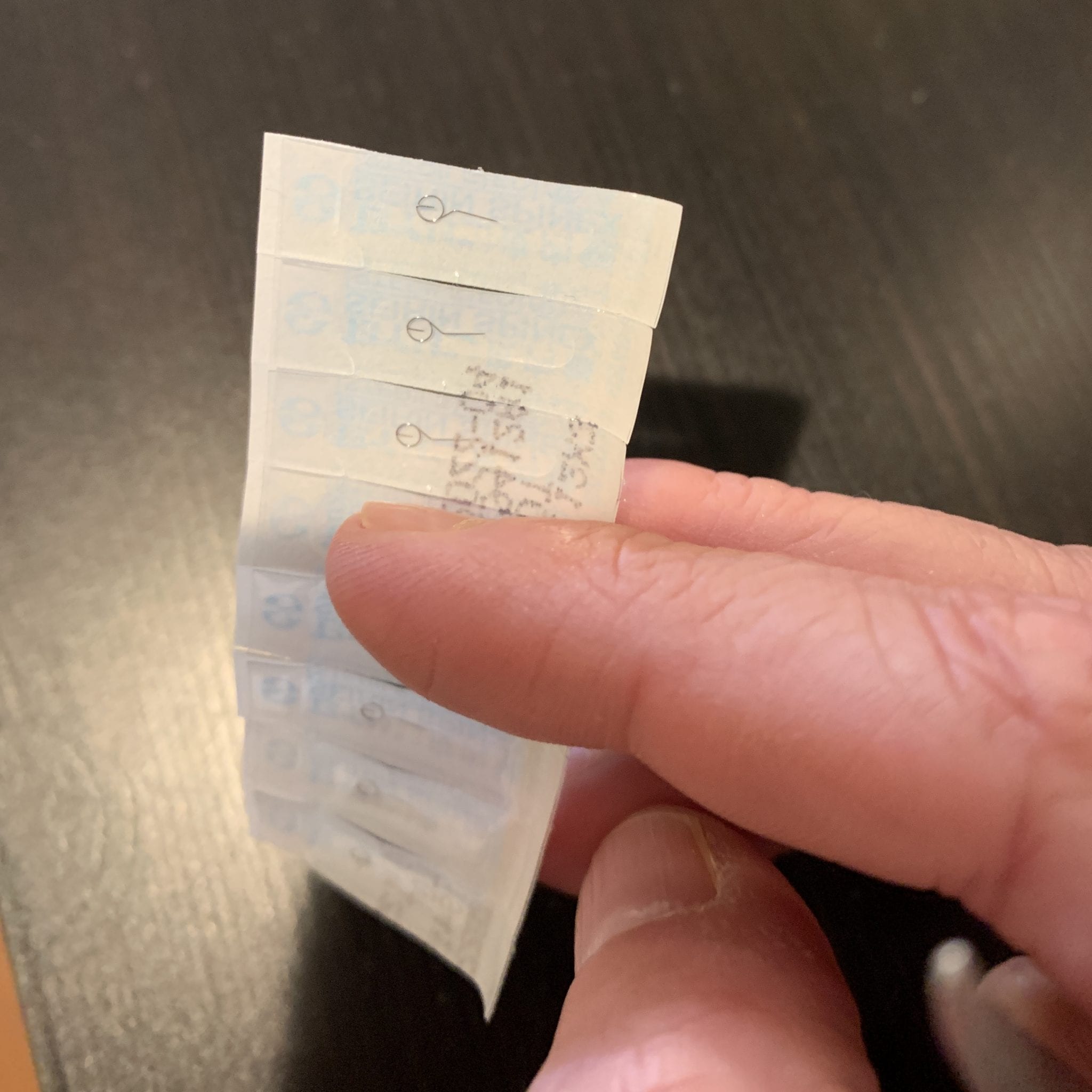
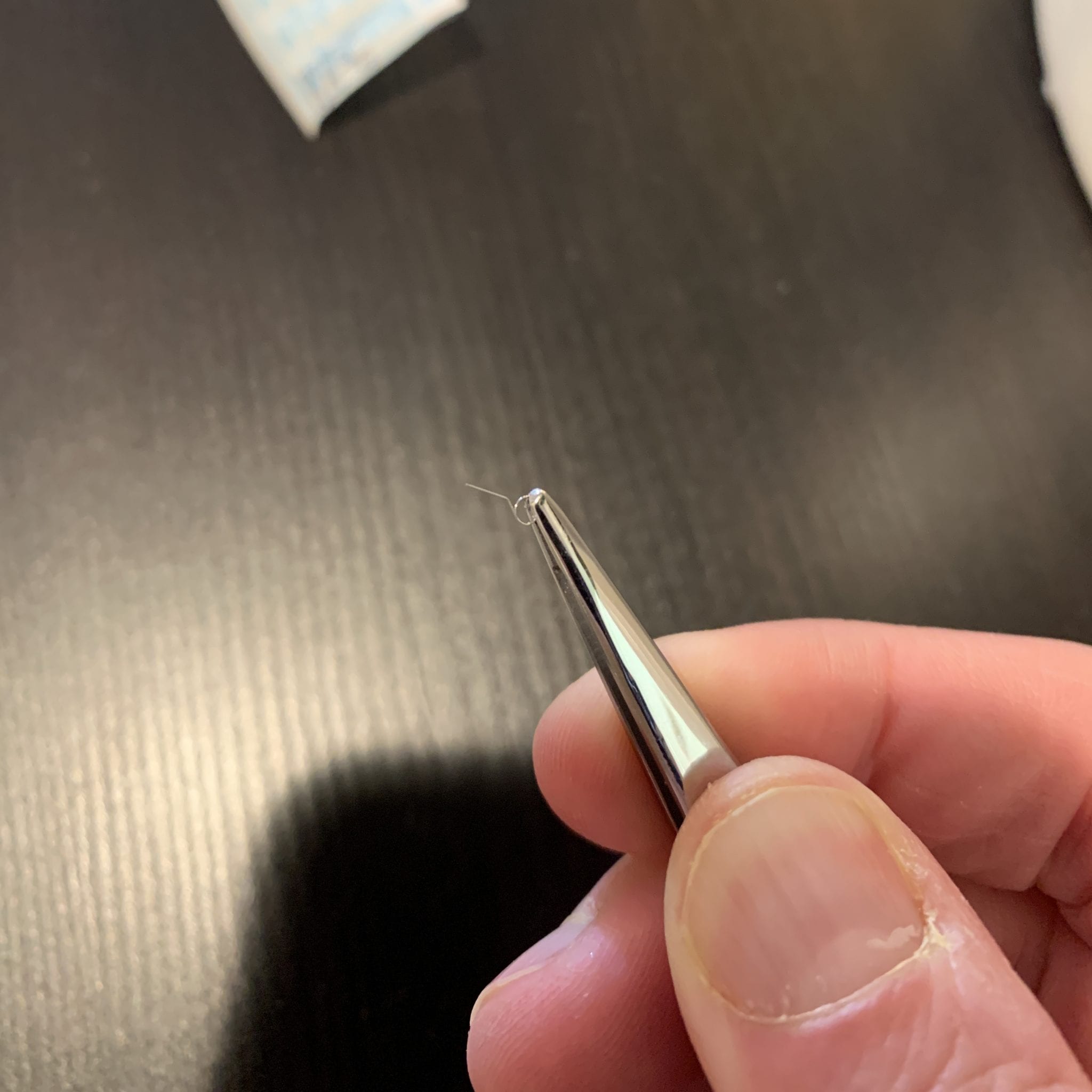
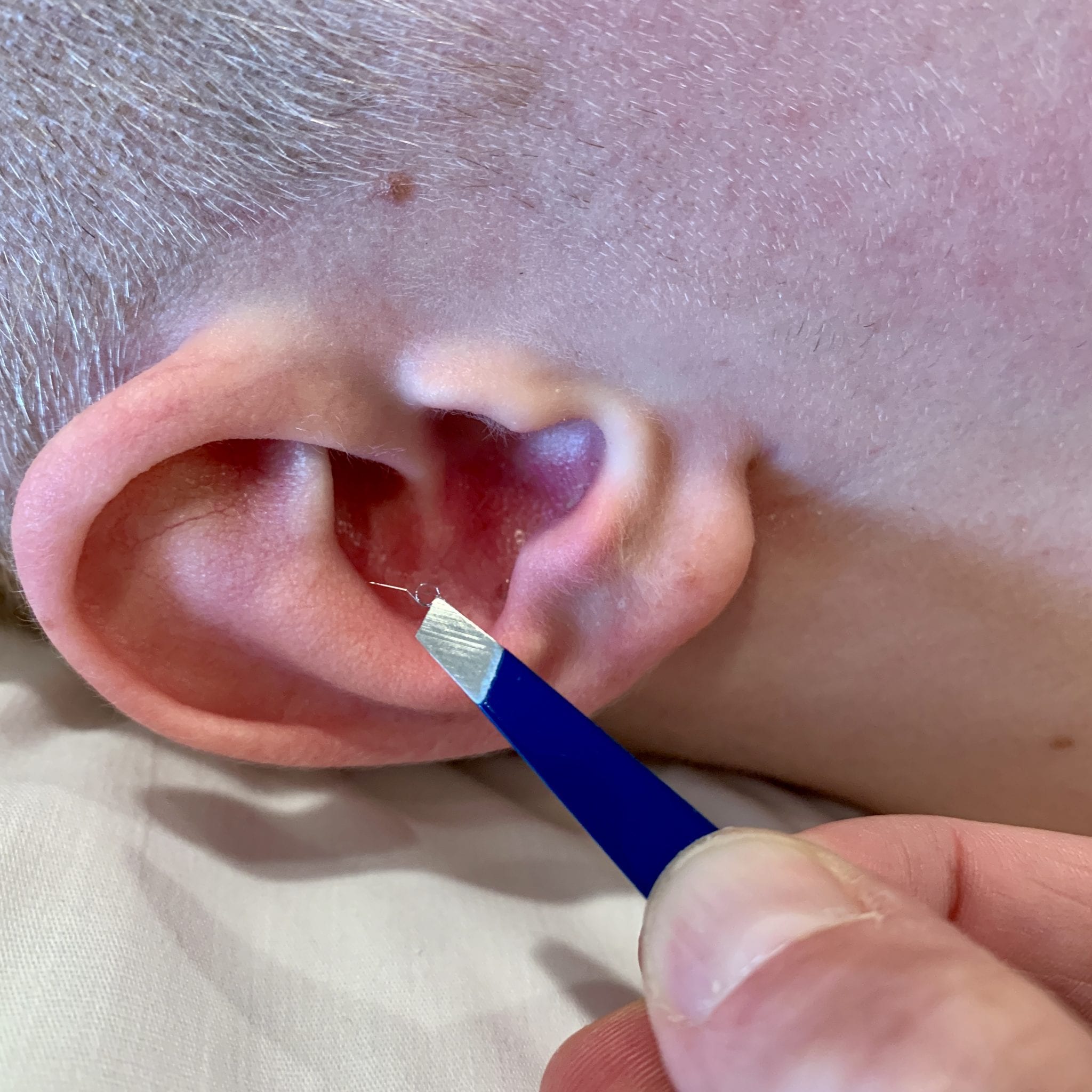
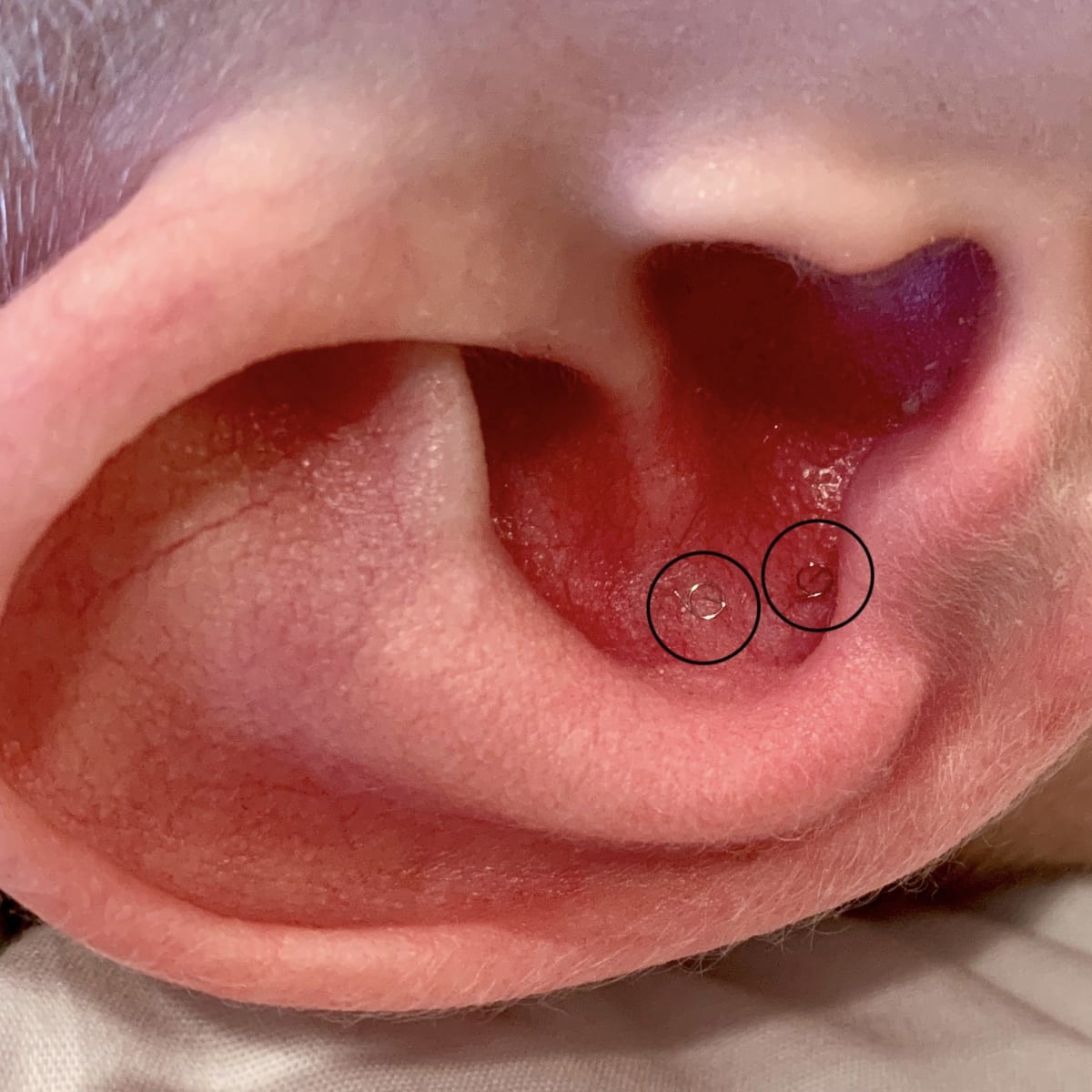
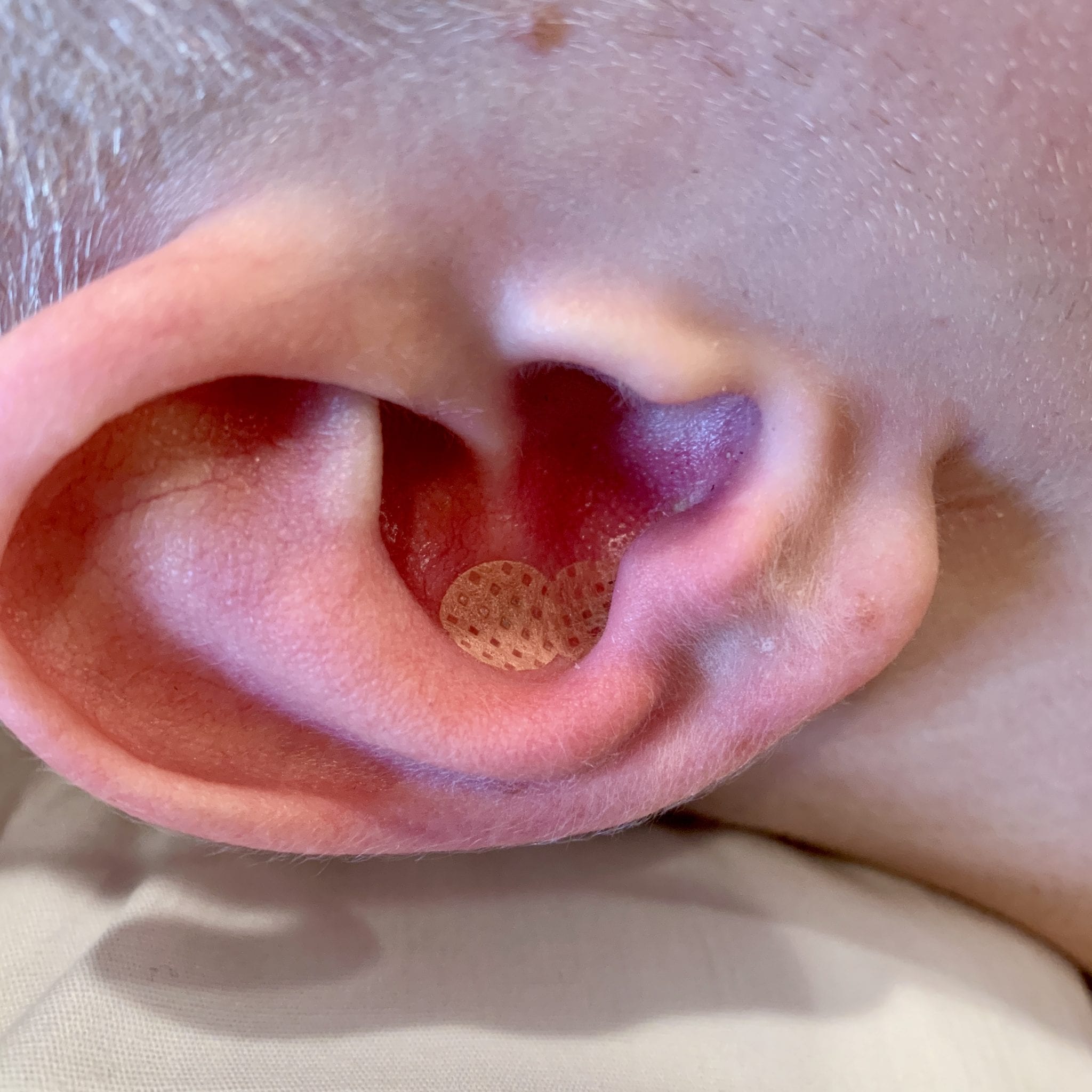
When should I schedule my SAAT session?
As you consider when to schedule your session, please keep the following in mind for the 3-4 weeks that the needle(s) are in place:
- The site around the SAAT needle needs to be kept dry. We will provide you with a cover to use while bathing, but please schedule your session at a time when you will be able to avoid swimming or other activities when your ears are likely to get wet.
- The site around the SAAT needle needs to be kept clean. The tape that is applied over the needle(s) is adequate to keep the site clean for normal wear, but it is best to avoid activities where you will be exposed to more than the usual amount of dirt, grime, and dust as long as the needles are in place.
- You will get the best results from SAAT if you avoid the allergenic substance(s) being treated for the 3-4 weeks that the needle(s) are in place. Food allergens should be avoided completely while the needles are in place. Exposure to environmental allergens should be minimized as much as is practical.
- If you have seasonal allergies, it is preferable to schedule SAAT prior to rather than during your usual allergy season.
How many treatments are required?
Assuming that the needle stays in place properly for 3-4 weeks, typically only one treatment is generally required for each allergen. In some cases we are able to treat up to four allergens in a single SAAT session (this will vary based on the severity of your allergy, the size of your ear, and the location of the active points associated with each allergen).
Clinical improvement, however, depends heavily on the identification and treatment all the allergens that are contributing to symptoms. For instance, if you experience allergic symptoms when you are around cats, you may be reacting to cat dander, cat hair, cat saliva, secretions from cat sebaceous glands, and/or cat urine. Although treating one of these substances with SAAT is likely to significantly reduce the intensity of your symptoms, the reaction will not go away until all facets of the allergy are addressed.
Seasonal allergy sufferers are typically reacting to multiple allergens — during peak allergy times, there may be dozens of pollens from various trees, grasses, and flowers, as well as substances like dust, mold, and fungus contributing to symptoms. In many cases we can treat “tree mix”, “grass mix”, or “mold mix” with a single SAAT needle, but if your reaction to a particular allergen is exceptionally severe that substance may need to be treated with its own needle.
In the case of alpha-gal allergy, it is important to keep in mind that the saliva from the Lone Star tick (the insect that triggers alpha-gal allergy) causes the human body to overproduce IgE. This means that, in addition to reacting to galactose-alpha-1,3-galactose (alpha-gal), sufferers may also develop allergies to other food and environmental substances as well. Relief of symptoms will depend on the identification of and treatment for all of these substances.
What is the testing procedure?
As noted above, the success of SAAT depends in large part on the identification of all substances that are provoking symptoms.
If you have already undergone allergy testing, please bring a printed copy of your results to your appointment. Please note that many experts believe that blood tests are not an accurate for diagnosing allergies. Elimination diets are often the most effective way of identifying food allergies.
If you have not already identified your allergies, you will need to schedule testing in our clinic prior to SAAT (testing can be performed on the same day as SAAT needle placement). We will use Bi-Digital O-Ring Testing (BDORT) and resonance samples to hone in on the substances that are contributing to your symptoms. You can learn more about BDORT here.
We are currently equipped with the resonance filters to test for the following allergens. If you require treatment for an allergen not on this list, please let us know in advance of your appointment so that we can obtain the resonance filter needed to test and treat you.
Acetaminophen
Alcohol Mix
Alpha-Gal
Amphetamines
Amyl Nitrate
Anesthesia
Anesthetics
Animal Dander
Animal Epithelial
Antibiotic Mix
Artificial Flavors
Artificial Sweeteners
Aspartame
Aspirin
B Complex
Bacteria Mix
Baking Powder
Baking Soda
Barbiturates
Bean / Legume Mix
Berry Mix
Caffeine
Calcium
Candida Mix
Carpet Mix
Cat
Cat
Cheese Mix
Chemicals
Chemotherapy Mix
Chicken
Chloride
Chlorine
Chloroform
Chocolate
Citrus Fruit Mix
Clorox/Bleach
Cocaine / Crack
Codeine
Coffee Mix
Corn Mix
Cortisone
Crystal Meth
Cucumber Mix
Dairy Mix
Dental Anesthesia
Detergent Mix
Dog
Dry Cleaning
Dust Mite
Dust Mix
Ecstasy / MDMA
Egg Mix
Egg White
Egg Yolk
Ephedrine
Epidural Mix
Fabric Mix
Fabric Softener
Fats, Animal
Fats, Vegetable
Feather Mix
Fel-D Protein
Fiberglass
Fish Mix
Flower Mix
Flu Mix
Fluoride
Foam Rubber
Food Additives
Food Color/Dyes
Food Preservatives
Formaldehyde
Fragrance Mix
Fruit Mix
Fungus Mix
Fur Mix
Gelatin
Grain Mix
Grass Mix
Gum Mix
Heavy Metals
Heroin
Hydrocortisone
Hydrogen Peroxide
Insect Mix
Iron
Isopropyl Alcohol
Latex
Lecithin
Lidocaine
LSD
Magnets
Marcaine
Marijuana
Mattress Mix
Meat Mix
Medications
Melon Mix
Mepavacaine
Mescaline
Methamphetamines
Methyl Salicylate
Milk Mix
Minerals
Mold Mix
Morphine
Newspaper
Newspaper Ink
Nitrous Oxide
Novacaine
Nut Mix
Onion Mix
Ort-Pho-Tyrosine
Paint Mix
Parasites Mix
PCP
Peanuts
Penicillin
Pepper Mix
Perfume
Pesticides
Peyote
Phenolics
Pitocin
Plastic Mix
Poison Oak/Ivy
Pollen Mix
Potato Mix
Prednisone
Pressboard
Prilocaine
Prozac
Psilocybin Mushrooms
Radiation
Ritalin
Rubber Mix
Salicylic Acid
Salt Mix
Shell Fish Mix
Silicone
Smoke
Smoking/Nicotine
Soybean Mix
Spices
Staph Mix
Starch Mix
Strep Mix
Styrofoam Sulfates
Sugar Mix
Sulfa-Drug Mix
Sulfites
Surgical Steel
Talc
Tape Mix
Tattoo Dye
Teflon
Tetracycline
Thiomersal
Tick Mix
Tobacco
Tomato Mix
Tranquilizers
Tree Mix
Turkey
Vaccines
Valium
Vegetables
Vicodin
Vinegar Mix
Virus Mix
Vitamin A
Vitamin C
Walnut Mix
Weed Mix
Wheat Mix
Whey
Wood
Wood Amalgam
Yeast Mix
Yogurt
Why do we use the ear?
Understanding the information below is not necessary in order to benefit from SAAT. I offer it, however, for those who want to understand how a body part that most people never think about (the external ear, also called the auricle) can serve as such a priceless diagnostic tool and can exert such a powerful therapeutic effect.
WE HAVE TO GO BACK TO THE VERY BEGINNING…
In order to understand what is unique about the auricle, we have to go back to look at the earliest stages of development of the human embryo. A human embryo begins as the union of a single egg and a single sperm, which progressively divides to form a multicellular organism as shown in FIGURE 1.

Once the embryo reaches the blastocyst stage, it begins to fold into itself. At this point, the cells begin to differentiate into three different tissue layers as shown in FIGURE 2. It is from these three distinct tissue layers that all body organs and structures are eventually formed.

As the cells continue to organize themselves, a recognizably human embryo forms. At 4 weeks, the primordial structures that will eventually form the ear become visible (see the circled area in FIGURE 3 below). These six “auricular hillocks” are made up of all three types of tissue (ectoderm, endoderm, and mesoderm).
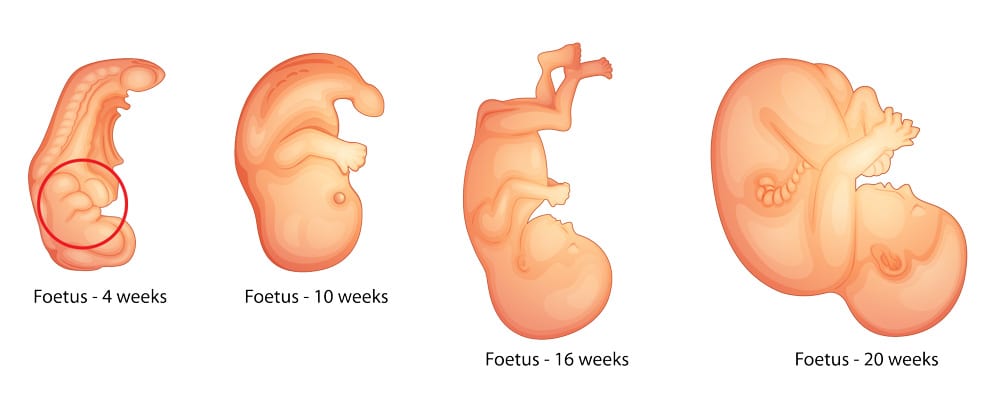
FIGURE 4 (below) depicts the maturation of the six auricular hillocks into the external ear (auricle).
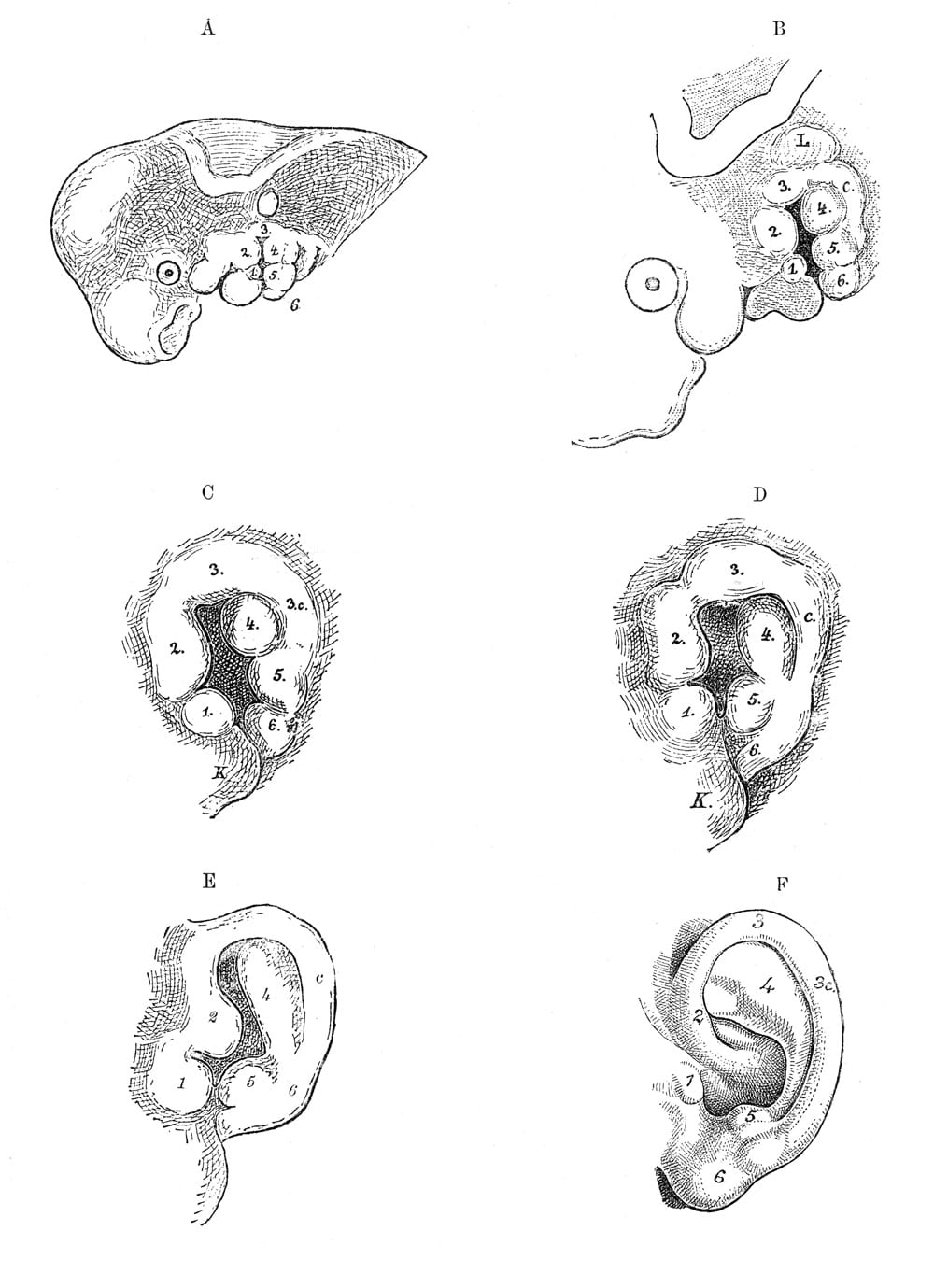
As mentioned above, the six hillocks that eventually develop into the auricle are made up of endodermal, mesodermal, and ectodermal tissue. In other regions of the body, these tissue layers eventually organize themselves into the following body structures:
| Endodermal Tissue | Mesodermal Tissue | Ectodermal Tissue |
|---|---|---|
| Stomach | Bones and muscles | Skin |
| Intestines | Fascia and connective tissue | Hair |
| Lungs | Heart and blood cells | Sweat glands |
| Liver | Blood and lymph vessels | Nerves |
| Pancreas | Spleen | Spinal cord |
| Vagus nerve | Kidney | Brain |
The auricular region associated with each of the three tissue types (see FIGURE 5) maintains resonance with/influence over other body structures formed from that embryonic tissue layer. As a result, the auricle serves as both a diagnostic and a treatment tool for the entire body.
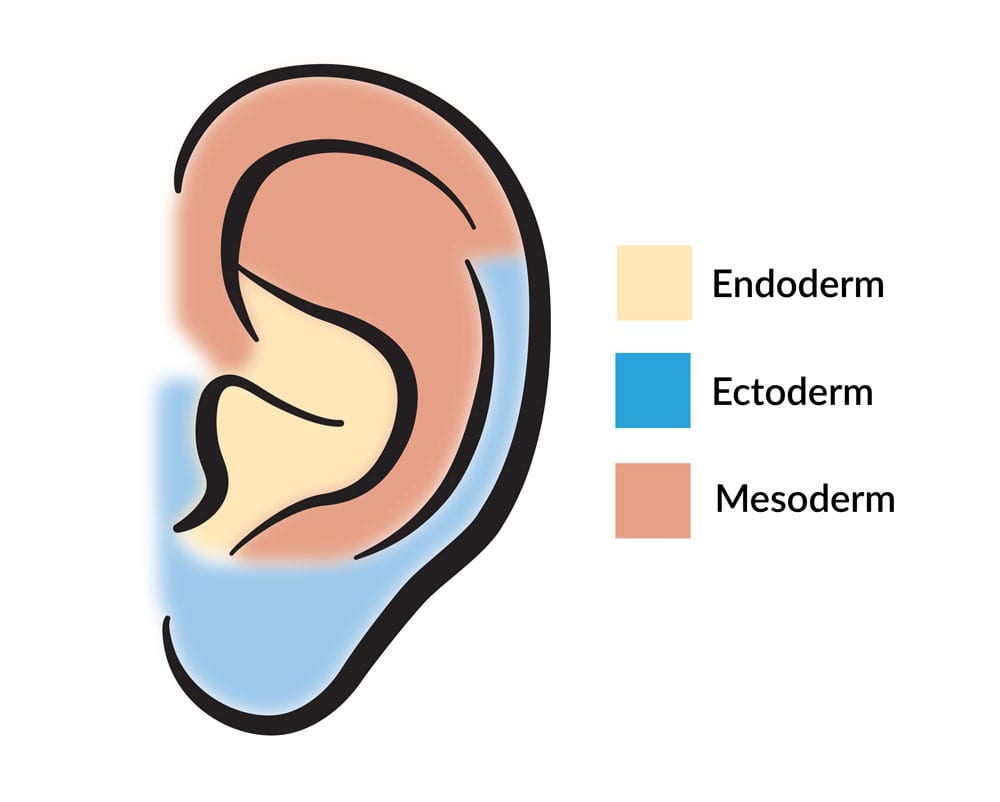
THE DIFFERENCE BETWEEN EAR AND BODY ACUPUNCTURE
Unlike body acupuncture points, which are found at the same anatomically-defined location on every person and are electrically active all the time, ear acupuncture points vary in location from one person to the next and are only detectable as electrically active when a problem exists with the associated body part. In this way they work sort of like a warning light on the instrument panel in a car.
DR. SOLIMAN’S DISCOVERY
Through decades of clinic experience and study, Dr. Soliman discovered that exposure to an allergenic substance causes the auricular area associated with the liver to expand to cover much of the concha region of the auricle (highlighted above in yellow). Placing a semi-permanent needle in the point that is most electrically active when exposed to a specific allergen (irritating substance) causes the body to stop overreacting to that substance.
Where can I learn more?
If you are on Facebook, I recommend joining the Alpha Gal SAAT Remission discussion group. Although the discussion there focuses on SAAT treatment of alpha gal allergy, there is a lot of information there about SAAT for other food allergies, as well as environmental allergies.
Dr. Donald Liebell was an early student of Dr. Soliman’s and has been using the technique very successfully in his clinic in Virginia for several years. You can visit his website to read several useful articles:
How much does it cost?
SOLIMAN AURICULAR ALLERGY TREATMENT (SAAT) FEES
| New Patient Consultation (required for any patient that has not been seen in our clinic within the past 24 months) | $100.00 |
| Bio-Energetic Testing (of up to 25 allergens per session, not needed if you have already had allergy testing elsewhere) | $100.00 |
| SAAT Treatment (one needle) | $200.00 |
| SAAT Treatment (each additional needle at a single session, up to a total of four needles) | $25.00 |
| SAAT Needle Replacement | $75.00 |
